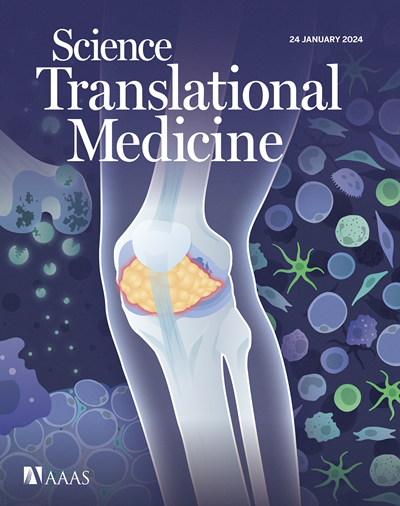Early detection of pancreatic cancer by a high-throughput protease-activated nanosensor assay
IF 15.8
1区 医学
Q1 CELL BIOLOGY
Science Translational Medicine
Pub Date : 2025-02-12
引用次数: 0
Abstract
Pancreatic ductal adenocarcinoma (PDAC) is among the top causes of cancer-related death. Patients are frequently diagnosed in the more advanced stages when effective treatment options are limited; however, earlier detection of PDAC by liquid biopsy may expand treatment options and improve survival outcomes. Here, we developed a noninvasive detection assay for PDAC based on serum protease activity to leverage the increase in cancer-associated protease activity in the peripheral blood of patients with PDAC. We screened a series of protease-cleavable peptide probes for the discrimination of PDAC samples versus healthy controls and noncancerous pancreatic disease. We identified a single MMP-sensitive probe, which could distinguish PDAC from controls with 79 ± 6% accuracy. We further developed this probe into a rapid magnetic nanosensor assay, termed PAC-MANN, that measures serum protease cleavage of a target-probe nanosensor with a simple fluorescent readout. In a longitudinal cohort of patients undergoing surgical removal of the primary tumor, the probe cleavage signal was reduced by 16 ± 24% after surgery. In a separate blinded retrospective study, the PAC-MANN assay identified PDAC samples with 98% specificity and 73% sensitivity across all stages and distinguished 100% of patients with noncancer pancreatic disease relative to patients with PDAC. The PAC-MANN assay combined with the clinical biomarker CA 19-9 was 85% sensitive for detection of stage I PDAC with 96% specificity. Therefore, the PAC-MANN assay is a rapid, high-throughput method that uses small blood volumes with the potential to enhance early PDAC detection, specifically among individuals at high risk of developing PDAC.
求助全文
约1分钟内获得全文
求助全文
来源期刊

Science Translational Medicine
CELL BIOLOGY-MEDICINE, RESEARCH & EXPERIMENTAL
CiteScore
26.70
自引率
1.20%
发文量
309
审稿时长
1.7 months
期刊介绍:
Science Translational Medicine is an online journal that focuses on publishing research at the intersection of science, engineering, and medicine. The goal of the journal is to promote human health by providing a platform for researchers from various disciplines to communicate their latest advancements in biomedical, translational, and clinical research.
The journal aims to address the slow translation of scientific knowledge into effective treatments and health measures. It publishes articles that fill the knowledge gaps between preclinical research and medical applications, with a focus on accelerating the translation of knowledge into new ways of preventing, diagnosing, and treating human diseases.
The scope of Science Translational Medicine includes various areas such as cardiovascular disease, immunology/vaccines, metabolism/diabetes/obesity, neuroscience/neurology/psychiatry, cancer, infectious diseases, policy, behavior, bioengineering, chemical genomics/drug discovery, imaging, applied physical sciences, medical nanotechnology, drug delivery, biomarkers, gene therapy/regenerative medicine, toxicology and pharmacokinetics, data mining, cell culture, animal and human studies, medical informatics, and other interdisciplinary approaches to medicine.
The target audience of the journal includes researchers and management in academia, government, and the biotechnology and pharmaceutical industries. It is also relevant to physician scientists, regulators, policy makers, investors, business developers, and funding agencies.
 求助内容:
求助内容: 应助结果提醒方式:
应助结果提醒方式:


